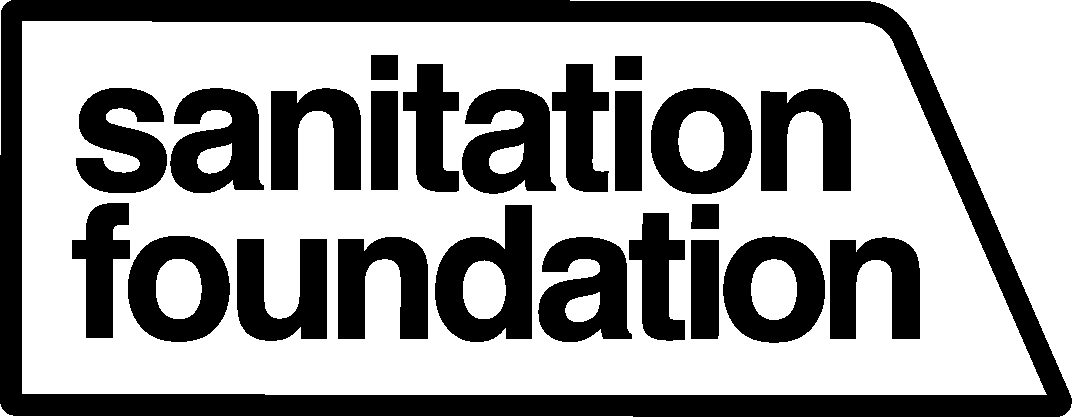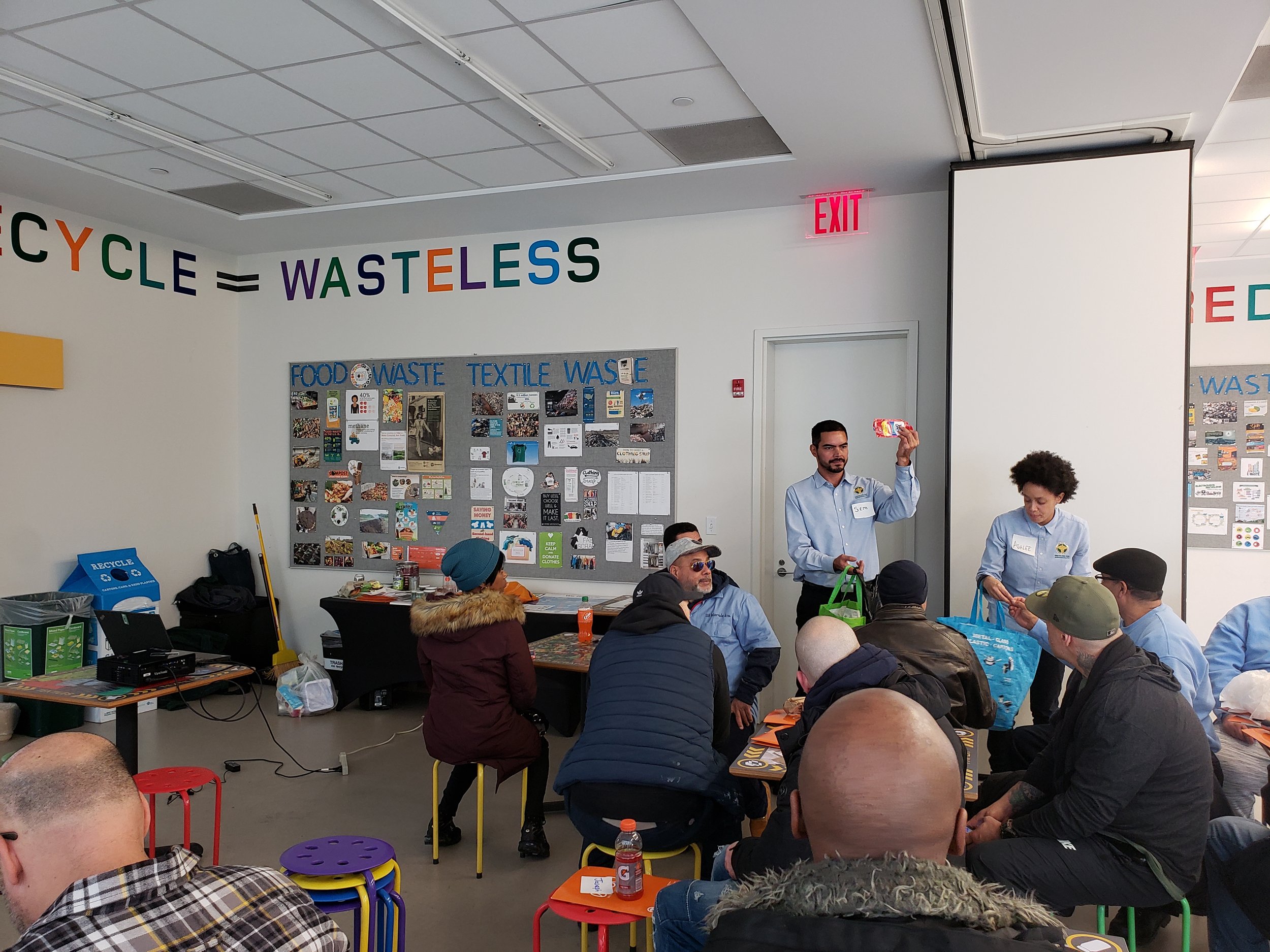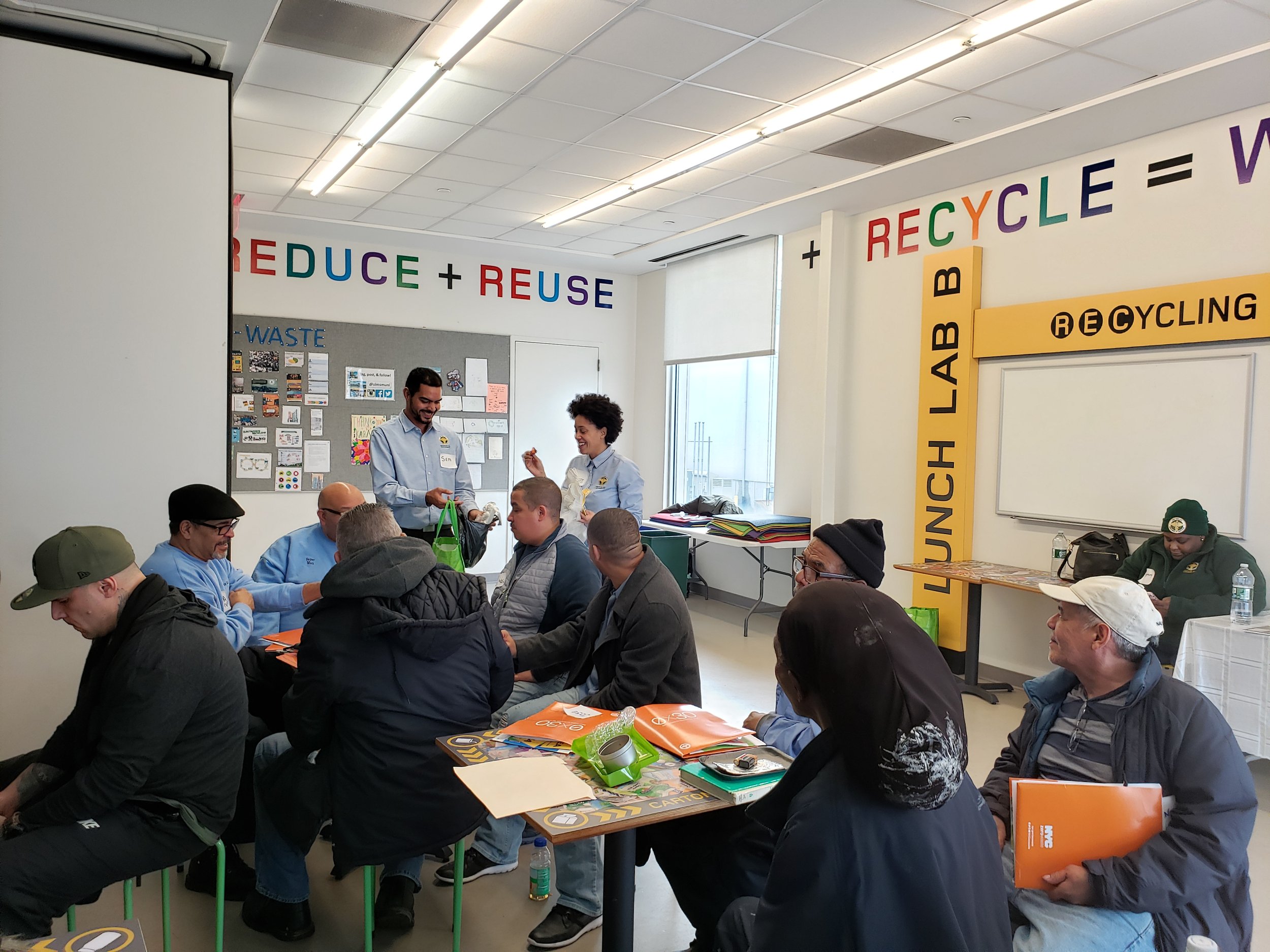Clean City Champion: Ashlee Barker, Operations Lead for Agencies & Buildings in DSNY’s Technical Assistance & Training Unit
“If it doesn't have to go to the landfill, let's try to make sure it doesn't go to the landfill!”
By Anne Whiting
Is it trash or recycling? Ashlee Barker loves educating New Yorkers about proper waste management and materials reuse.
Clean City Champion Ashlee Barker is a reuse and recycling champion. As the Operations Lead for Agencies & Buildings in the NYC Department of Sanitation’s (DSNY) Technical Assistance & Training Unit, she helps both residential and commercial buildings around New York City learn how to properly dispose of all waste types in compliance with the City’s trash and recycling rules. She also manages two of DSNY’s programs, Agency Safe Handling and Clean Buildings Training.
Ashlee Barker began her career in DSNY’s Bureau of Recycling and Sustainability (BRS), after receiving her MPA from Baruch College. Her first role in the Agency was Senior Manager of Apartment Programs, helping to promote programs like ecycleNYC (an in-building electronics collection program), refashionNYC (an in-building textile collection program), and Clean Buildings Trainings. Next, she joined BRS’ Special Waste Unit, where she coordinated harmful household waste collection programs and managed household hazardous waste contracts with recyclers, waste handlers, and disposal companies.
Ashlee is currently DSNY’s Operations Lead for Agencies & Buildings. She helps her team train NYC apartment building staff and management, NYC agency staff, and residents in all aspects of DSNY's recycling, composting, and waste prevention programs.
Passionate about educating the public about recycling, Ashlee is determined to direct recyclable materials to the right place and promote reuse so that usable items don’t have to become trash.
As we wrap up our NYC Big Spring Clean and launch our newest program Adopt Your Spot NYC, the Sanitation Foundation sat down with Ashlee to learn some of her expert tips and tricks for reducing our waste. Here are the takeaways.
1. Awareness is key.
Ashlee is from Upstate New York, where she says she learned about the connections between nature and waste at an early age. On a hike Upstate, for instance, litter is uncommon, so it’s easy to notice trash and feel compelled to want to pick it up. Meanwhile, in the City, people have gotten too used to seeing litter. She also notes how in New York City, it’s so easy to get rid of things because waste is conveniently collected at the curb and is free to residents. Whereas Upstate, people have to pay and specially arrange for all waste removal services, from their daily trash and recyclables to larger items like furniture and televisions. New York City dwellers take for granted the convenience that DSNY provides them. They don’t see a landfill; they don’t see where their trash is going. It’s important that people start thinking about where their waste winds up, and who is picking it up — and, of course, how to produce less waste.
2. There are small ways we can make a difference.
“You don't have to be doing everything perfectly all the time,” says Ashlee. She recommends making small changes one by one, because trying to fix all wasteful habits simultaneously can be overwhelming if not impossible. She points to simple measures like opting out of paper mail, not asking for plastic utensils with food delivery, remembering to bring your own headphones on an airplane, and dropping off food scraps in a DSNY Smart Compost Bin if Curbside Compost Collection is not yet available in your neighborhood.
“Little things make such a big difference,” she says, even though she works with large-scale waste issues in big buildings. “Pick up a piece of trash on your walk home, for example.” If everybody did one easy and quick thing every day, Ashlee says it would have an impact.
She recommends that apartment buildings sign up for ecycleNYC and refashionNYC, because they’re convenient and free. DSNY also makes it easy to dispose of nontraditional waste by visiting Special Waste Drop-Off sites and SAFE Disposal events.
3. NYC is full of great reuse partners who are helping New Yorkers to recirculate their waste every day.
Throughout her career, Ashlee has served as a DSNY liaison with the reuse and material donations sector across New York City. Her mission has been to drive awareness of Agency recycling and reuse partners like Housing Works thrift shops, PaintCare, and ERI, which have supported DSNY's efforts to help New Yorkers to divert waste from landfills.
She also advises New Yorkers to check out groups like Buy Nothing and Stooping NYC for resources to reuse items in good condition instead of putting them out with the trash, especially large items like couches. (She also suggests that building residents get together to create a community listserv or bulletin board of items up for grab, so that people can use and save things from neighbors instead of letting them go to landfill!)
4. Recycling Legislation is a good thing.
Part of Ashlee’s role involves developing new programs to help apartment buildings comply with new laws and rules regarding diversion of materials, such as e-waste, paints, and textiles from landfills.
One such law is the Electronic Equipment Recycling and Reuse Act passed in 2015, which requires many vendors, such as Best Buy and Staples, to take back old electronics for recycling. You can call the company you bought an item from to check if they have a take-back program for computers (and accessories), TVs, video equipment, portable electronic devices, and other home electronics like digital picture frames and VR headsets. (Check out our FAQ for more information, or visit nyc.gov/electronics for more information and details about e-waste recycling options!)
A Clean Buildings Training also helps buildings properly label best waste disposal practices.
5. DSNY provides the tools to help get your community involved.
DSNY’s Clean Buildings Trainings teach property managers, superintendents, and porters to understand best waste management practices and properly set out waste on the curb for DSNY collection. This supplements services and partnerships like ecycleNYC, refashionNYC, Special Waste Drop-Off sites, and SAFE Disposal events. Ashlee hopes New York apartment building managers and residents alike will engage in the opportunities to learn more about proper waste management, such as the NYC Residents Training and the Residential Maintenance Staff Trainings.
“I would love for people to reach out to me for help — we can meet virtually, in person, at your building, at our office — wherever. We will bring a training to you. We work with City agencies, so if you’re in a City government building and you just need to know, ‘What do I do with waste at my desk? Or what do I do with coffee cups or takeout containers?’ We have trainings for that.”
You can also check out Sanitation Foundation cleanup opportunities. We just launched a new program called Adopt Your Spot NYC, a unique opportunity for New Yorkers who want to step up to take care of a “spot” that’s especially dear to them by maintaining it and keeping it free from litter over the course of one year. Head to our website to learn more! We also offer Training & Resources, Starter Kits & Tool Grants, and a DSNY Tool Loan Program. Visit our Community-Led Cleanup Resources and Volunteer Cleanup Programs pages for more information.
Ashlee advocates for taking ownership of your waste and the waste in your neighborhood. You can keep it simple and local and still have a great impact on New York City.
“There's a lot of great groups that have volunteer opportunities in your neighborhood. Your local Business Improvement District will also have opportunities for you to engage. You can do something as simple as clean up a single tree bed in your neighborhood. The ownership of that is really wonderful, and you get to meet people in your community.”
Are you interested in organizing a Clean Buildings Training to learn more about managing special waste in your building? Trainings can be done virtually, in person, or at a DSNY office. Check out DSNY’s website for more information, or contact cleanbuildings@dsny.nyc.gov with any inquiries.





